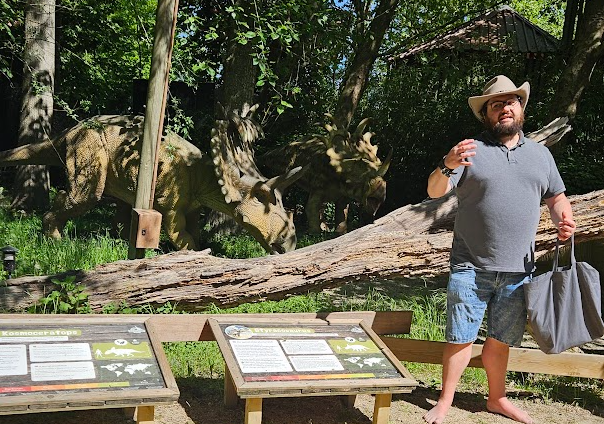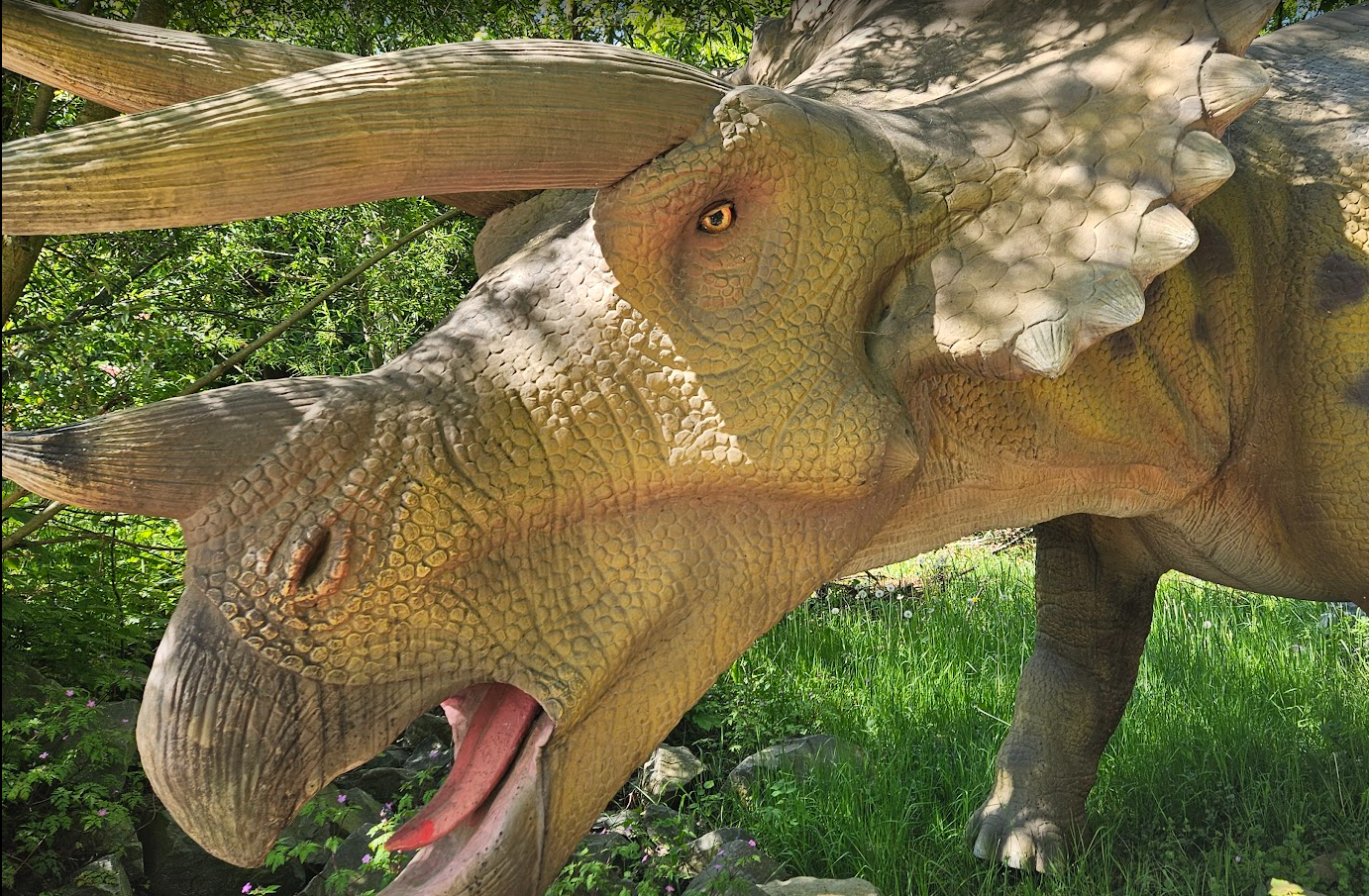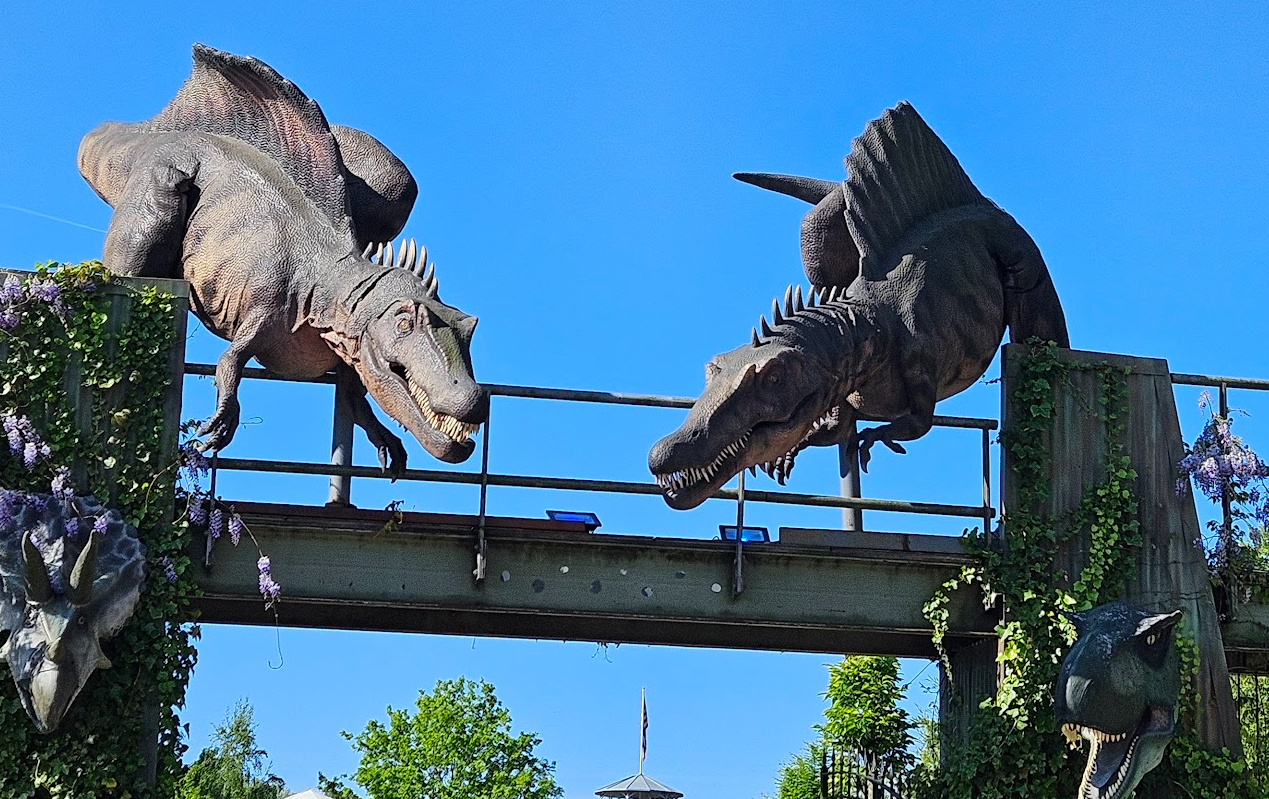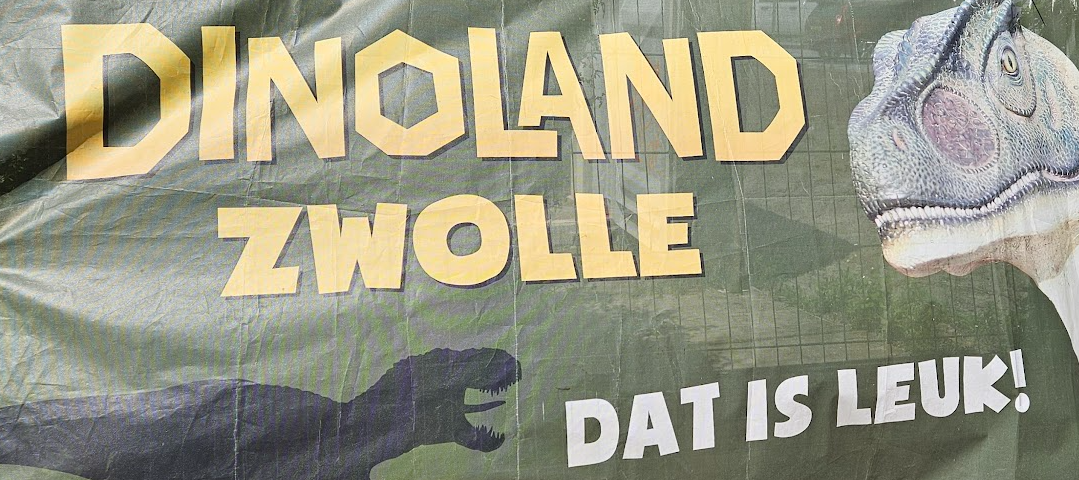Rachèl Blokhuis-Koopman & Ernst van den Hemel
“Dinoland: That’s Fun!” The slogan immediately reveals what the Dinoland theme park in Zwolle is all about. Like all theme parks, Dinoland combines information with entertainment. Two animatronic dinosaurs on the gate above the entrance screech at us as we walk into the park. Inside, you’ll find life-sized dinosaur sculptures, sandpits where you can dig up fossils, VR environments, and theater performances after which you can take a photo with a dinosaur. In this way, visitors learn about prehistory through play.
At the same time, it is also a place where a radically different view of (pre)history is present. In Dinoland, on this Saturday in May between ten and twelve o’clock, a story is told in which dinosaurs are not part of prehistory, but of recent Biblical events. The tour is organized by the Logos Institute, a foundation committed to promoting creationism in the Netherlands and Belgium, and is led by Gert-Jan van Heugten. Gert-Jan is a researcher and speaker who gives lectures on various topics and was specifically invited by the Logos Institute to explain how Young Earth creationism views dinosaurs and prehistory.

Young Earth Creationism is a movement within Christianity that takes the Bible—particularly the creation story in Genesis—literally. According to this interpretation, the Earth is about six thousand years old, based on biblical genealogies. This directly contradicts the scientific consensus of a billions-of-years-old Earth. Dinosaurs, according to this view, did not go extinct 65 million years ago due to a meteor impact, but only after the Great Flood, because the climate changed drastically. This interpretation implies that humans and dinosaurs lived together, and that dinosaurs were taken aboard Noah’s Ark.
The origins of this line of thought lie partly in 19th-century America, where a protest movement emerged in response to the rise of Darwinism, advocating for "Biblical science." This movement took shape in The Fundamentals (1910–1915), a series of pamphlets that laid the foundation for Christian fundamentalism. Within this framework, the inerrancy of the Bible was defended against the rise of modernity, evolutionary theory, and the historical-critical method of Biblical interpretation—an academic approach that originated particularly in Germany. A literal reading of Scripture was regarded as the primary counterargument. In the United States, Young Earth creationism is promoted through various media by organizations such as Answers in Genesis, with tangible examples including the Creation Museum and the Ark Encounter in Kentucky. Today, about 37% of Americans believe in Young Earth creationism.
In the Netherlands, young-Earth creationism is generally supported by evangelical Christians and by certain groups within the orthodox Protestant community. This worldview is also promoted in the Netherlands through various forms of media. The Logos Institute translates many of these ideas and publications for a Dutch-speaking audience and publishes, among other things, children's books, DVDs, and travel books. They also organize guided tours in Dinoland.
We are given a guided tour through the park and stop now and then at dinosaur statues, where we receive information about the difference between evolutionary science and science based on the Bible. The guide presents the key points of young-earth creationism in an accessible way. The rhetorical style of the guide also closely resembles the strategies used by organizations such as Answers in Genesis. For example, young-earth creationists often talk about how science fills in the gaps in our knowledge. Excavated bones are pieced together in ways that we cannot be sure are accurate. Young-earth creationists frequently use this argument to support their worldview: because there is still so much we don’t know, it’s entirely possible that there are completely different explanations for phenomena such as the Big Bang, evolution, or the extinction of the dinosaurs. Our guide makes a similar point: we don’t know what color the dinosaurs were, or whether they made sounds. So the animatronic dinosaurs brought to life above the entrance of Dinoland, roaring at us with a Jurassic Park–like screech, may say more about our imagination than about prehistory.
In response to these uncertainties within the evolutionary perspective, the guide emphasizes that the Bible does offer a consistent explanation. For example, the theory of evolution is said to lack a convincing explanation for the Ice Age. But from the flood model, as described in Genesis, the onset of an Ice Age becomes understandable. The global flood drastically changed the ecology and climate, making a cooling period after a time of warmth plausible. Within young Earth creationism, this view is not presented as a conflict between faith and science, but as a battle between two kinds of science: science without the Bible (evolution theory) versus science with the Bible (creationism). In this view, science with the Bible is simply better at explaining geological and biological developments.
Another commonly used argument is the worldwide presence of dragon stories in ancient mythologies. Why is it that people all over the world tell stories about dragons? Young Earth creationists argue that, from an evolutionary perspective—in which humans and dinosaurs never lived at the same time—this is difficult to explain. But the Young Earth creationist viewpoint, in which humans and dinosaurs did live together, sees dragon stories as evidence supporting their worldview. Dragon stories are thus seen as historical evidence of actual encounters with dinosaurs.
This shows us that dinosaurs are used as exciting and accessible illustrations of a worldview. We see this clearly in the previously mentioned Creation Museum in Kentucky. As the name suggests, it is a museum where the creationist view of the Earth is laid out. They use immersive media to immerse the public in the claims of young Earth creationism through attractions, animatronic dinosaurs, and 4D cinema. As you walk among the lifelike dinosaurs and receive information about the Flood, Creation, and dragon legends, you can imagine what it must have been like when humans and dinosaurs lived together.
Young Earth creationists are not the only ones who combine immersive dinosaur presentations with educational content. For example, ever since the first dinosaur exhibitions, dinosaurs have been displayed in multimedia formats. The Jurassic Park film series has been fueling dinosaur hype for decades and has led to increases in the number of paleontology students. Dinosaurs are also presented in spectacular ways in museums. As we discussed elsewhere on this blog, natural history museums like Naturalis use a wide variety of media forms to give meaning to nature and the history of the Earth. Fossils—such as that of the Tyrannosaurus rex, Trix—are staged and illuminated in ways that maximize immersion and experience (in Naturalis, for instance, the fossils are displayed against a projection screen that, through sound and visuals, gives the impression of being in a forest with living dinosaurs).Naturalis even features theme park-style “dark rides.” In the Rexperience at Naturalis, for example, you experience a multimedia adventure where you travel back in time via a time machine, crash-land in prehistory, and narrowly escape just before a comet impact.

The tour in Dinoland, in short, fits within a broader spectrum and longer tradition of practices in which sensational depictions of dinosaurs are used in various ways and from various angles to convey stories about creation and the origin of humanity. The appeal of dinosaurs can be used to make prehistory or a literal reading of the Bible convincing. Although the views of the Logos Institute and places like Dinoland or Naturalis are literally millions of years apart, they both use new forms of media to engage people in their educational mission. This presents a productive field of research for us as MAKEBELIEF researchers: what are the pros and cons of using entertainment? In what ways are our senses engaged by religious groups, museums, and other organizations? What are the limits of immersive education?
Our guide emphasized that dinosaurs are simply allowed to be fun. During the tour, we were explicitly reminded that we could stay in the park for the rest of the day. For the remainder of the day, these differences hardly mattered: the children were mostly busy digging for gemstones and fossils.


